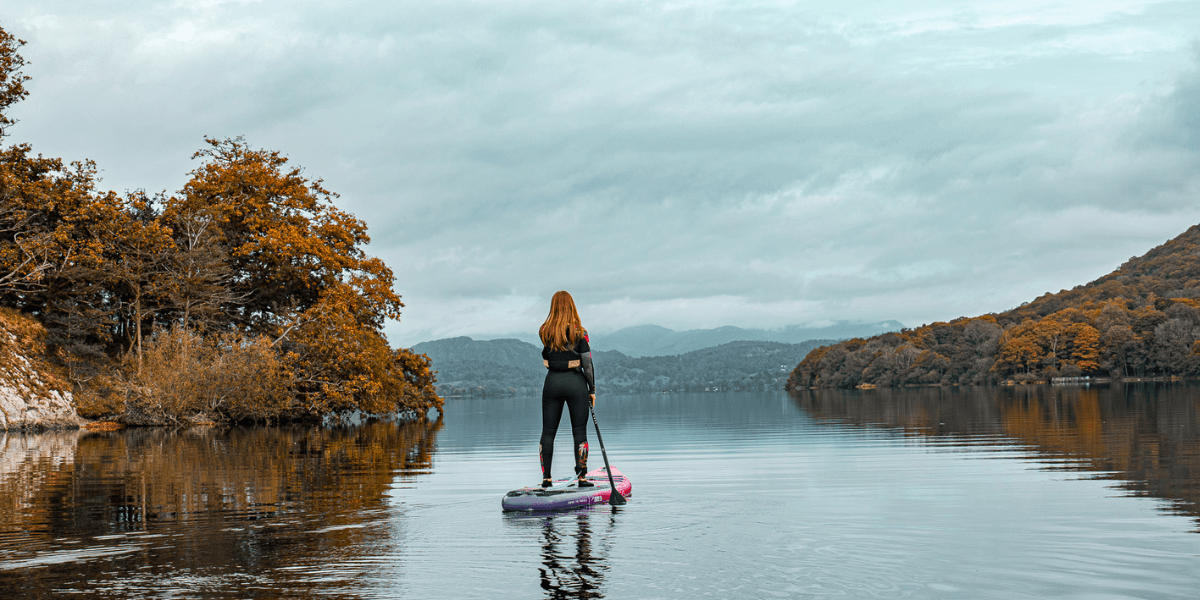
Table of content
Introduction
Even the best paddlers started out wobbly. Paddleboarding looks effortless, but getting the hang of balance, stance, and paddle technique takes a bit of practice. The good news? Most common mistakes are easy to spot and even easier to fix once you know what’s going wrong.
So, whether you’re new to SUP or just looking to sharpen your skills, here are the most common mistakes we see and how to correct them so you can paddle smoother, straighter, and with more confidence.
SUP Session Checklist
Inflate your board to the correct PSI
Secure your fin and leash
Adjust your paddle height around 8–10 inches above your head
Put on a buoyancy aid or PFD
Check the weather and wind direction
Pack a dry bag with water, snacks, and your phone in a waterproof case

1. Standing Too Far Back on the Board
The mistake: Many beginners stand too close to the tail of the board, which makes it feel unstable and causes the nose to lift.
The fix: Stand with your feet either side of the centre carry handle, this is the board’s centre point. Keep your knees soft and slightly bent and your weight evenly distributed. You’ll instantly notice better stability and smoother tracking through the water.
SUP Products You'll Love
2. Holding the Paddle the Wrong Way
The mistake: It’s surprisingly common to see paddlers using the paddle backwards, with the blade angled toward them. This makes paddling harder and less efficient.
The fix: The blade should angle away from you. The curved side faces forward so it slices cleanly through the water. A simple way to remember this is to think of the paddle as a spoon for scooping water, with the handle being the end of the spoon that scoops the water towards you, not away.

3. Using Your Arms Instead of Your Core
The mistake: Relying on arm strength alone makes paddling tiring and less effective.
The fix: Rotate your torso and engage your core with each stroke. Your arms should act more like guides than levers. This will help you generate more power, paddle longer, and keep your movements smooth and balanced.
4. Looking Down Instead of Ahead
The mistake: Staring at your feet or the board feels safer, but it actually throws off your balance.
The fix: Keep your gaze fixed on the horizon or a point ahead of you. Your body naturally follows where you look, helping you stay centred and upright. This one small change can instantly boost your stability.

5. Paddling on Only One Side
The mistake: Many beginners stick to one side without adjusting their stroke, causing the board to drift off course and wasting energy correcting direction.
The fix: If you’re paddling casually, switch sides every few strokes to stay straight and balanced. But as you progress, try learning a J-stroke or C-stroke, these techniques let you keep paddling on one side while subtly steering the board straight. They’re great for improving control, especially in wind or when carrying speed.
6. Ignoring Wind and Weather
The mistake: Heading out without checking conditions can make a relaxing paddle stressful or even unsafe.
The fix: Always check the wind direction before launching. Start your session paddling into the wind if there is any so that you have an easier ride back. Avoid strong offshore winds, and remember that flat, calm mornings are usually best for beginners.
7. Skipping a Warm-Up or Safety Check
The mistake: Jumping straight on the board without checking your leash, fin, or inflation pressure can lead to problems mid-session.
The fix: Do a quick pre-paddle check every time: board fully inflated, leash attached, fin secure, paddle length adjusted, and PFD fitted. A quick stretch also helps loosen your shoulders and legs, reducing the risk of cramps.

Practice Makes Perfect
Everyone makes mistakes when they start, that’s part of the fun. The key is learning from them, taking your time, and paddling often. With a few small adjustments, you’ll notice a huge improvement in your stability, speed, and confidence on the water.
And if your current setup’s holding you back, now’s a great time to upgrade. Our Black Friday offers are coming soon, with brilliant deals across our full SUP range from beginner-friendly Cruise boards to high-performance Carbon models. Get the gear that helps you paddle better, and make your next session your best one yet.
FAQ
How long does it take to get good at paddleboarding?
Most beginners find their balance within the first session. After a few outings, you’ll feel confident paddling straight and turning smoothly.
Do I need to be strong to paddleboard?
Not really, paddleboarding relies more on balance and technique than strength. Engaging your core, not your arms, helps you paddle more efficiently.
What should I wear when paddleboarding?
In warmer months, quick-dry clothing or a swimsuit is fine. In cooler weather, opt for a wetsuit or layers with a waterproof top to stay warm and comfortable.
Can I paddleboard in winter?
Yes, as long as you dress for the conditions. Wear a wetsuit or drysuit, check the weather forecast, and avoid paddling alone in very cold or windy conditions.
SUP Products You'll Love
Related readings
Take your paddleboarding to the next level!
Black Friday is almost here get ready to upgrade your board and gear with our biggest offers of the year.




Share:
Paddleboarding for Fitness: A Full-Body Workout You’ll Actually Stick To
Autumn Paddleboarding Events Across the UK